Oral
Psychiatric Neuroimaging: Towards Grounding Clinical Diagnosis in Biology
ISMRM & SMRT Annual Meeting • 15-20 May 2021

| Concurrent 4 | 18:00 - 20:00 | Moderators: Chuan Huang & Fei Li |
0195.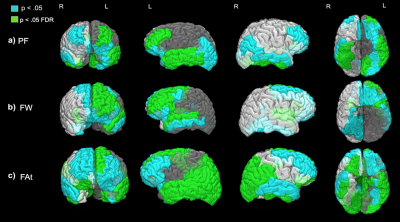 |
Three-Compartment IVIM Model Applied to Psychotic Spectrum Disorders
Faye McKenna1, Yu Veronica Sui1, Hillary Bertisch1, Donald Goff1, and Mariana Lazar1
1New York University School of Medicine, New York, NY, United States
We applied a three compartment intravoxel incoherent motion (IVIM) technique that estimated the perfusion fraction (PF), free water (FW), and anisotropic diffusion of tissue (FAt) to detect microvascular and microstructural changes in a cohort of 54 psychotic spectrum disorder (PSD) patients compared to 35 healthy controls (HC). We found significantly increased PF, FW and FAt in PSD and PSD subtypes compared to HC, primarily in the frontal and temporal lobes and cingulate and insular cortices at multiple comparisons correction level. In patients, IVIM metrics were found to be associated with the duration of psychosis and performance on several cognitive tests.
|
||
0196.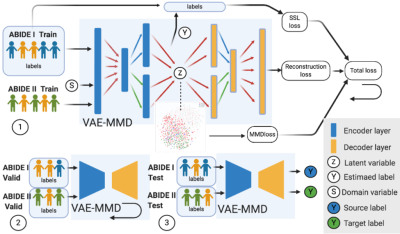 |
VAE deep learning model with domain adaptation and harmonization for diagnostic classification from multi-site neuroimaging data
Bonian Lu1, Rangaprakash Deshpande2, Madhura Ingalhalikar3, and Gopikrishna Deshpande1
1Electrical and Computer Engineering, AU MRI Research Center, Auburn University, Auburn, AL, United States, 2Athinoula A. Martinos Center for Biomedical Imaging, Massachusetts General Hospital, Medical School and Harvard-MIT Health Sciences and Technology, Charlestown, MA, United States, 3Symbiosis Center for Medical Image Analysis, Symbiosis International University, Pune, India
In large public multi-site fMRI datasets, the sample characteristics, data acquisition methods and pre-processing approaches vary across sites and datasets, leading to poor diagnostic classification. Domain adaptation aims to improve the classification performance in target domain data by utilizing the knowledge learned from the source domain, and making the distributions of data in source and target domains as similar as possible. In this sense, domain adaptation is one method that can be used to achieve and optimize transfer learning by using different datasets.
|
||
0197.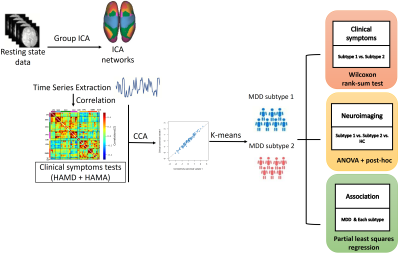 |
Data-driven clustering differentiates subtypes of major depressive disorder with distinct connectivity-symptom association
Yanlin Wang1, Shi Tang1, Xinyu Hu1, Yongbo Hu1, Weihong Kuang2, Zhiyun Jia1, Xiaoqi Huang1, and Qiyong Gong1
1Department of Radiology, West China Hospital, Sichuan University, Huaxi MR Research Center (HMRRC), Functional and molecular imaging Key Laboratory of Sichuan Province, Chengdu, China, 2Department of Psychiatry, Sichuan University West China Hospital, Chengdu, China
Major depressive disorder (MDD) is a clinically heterogeneous syndrome and commonly co-occur alongside symptoms of other psychiatric domains. It is challenging to identify the correspondence between these clinical heterogeneous and relevant neurobiological substrates and define neurophysiological subtypes of MDD. We used regularized canonical correlation analysis (rCCA) to assess a two-dimensional mapping between the intrinsic connectivity networks (ICNs) and clinical symptoms and thus aid in defined MDD subtypes. We then compared potential symptom severity and neural features alterations between these subtypes and further assess the association between these features.
|
||
0198.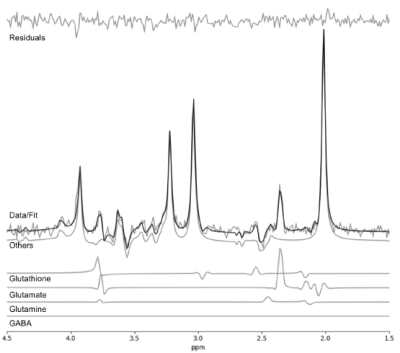 |
Glutamatergic responses to a color-word Stroop task in first-episode schizophrenia: A 7-Tesla functional MRS study
Peter Jeon1, Michael MacKinley2, Kara Dempster3, Dickson Wong4, Lena Palaniyappan1,2,5,6, and Jean Theberge1,5,7
1Medical Biophysics, Western University, London, ON, Canada, 2Neuroscience, Western University, London, ON, Canada, 3Psychiatry, Dalhousie University, Halifax, NS, Canada, 4Schulich School of Medicine and Dentistry, Western University, London, ON, Canada, 5Psychiatry, Western University, London, ON, Canada, 6Robarts Research Institute, London, ON, Canada, 7Lawson Health Research Institute, London, ON, Canada
Dynamic behaviour of neurometabolites require tools that are able to capture such temporal information. Functional MRS can track metabolite level changes in response to external stimuli, providing valuable observations for illnesses such as schizophrenia. This study employed a 7-Tesla fMRS technique to study the anterior cingulate cortex glutamate, glutamine, and glutathione dynamic behaviours in 38 first-episode schizophrenia and 27 healthy controls. In response to a color-word Stroop task, significant differences were observed in resting and dynamic glutathione levels, supporting abnormal neurometabolite behaviour or circuitry in the early stages of schizophrenia.
|
||
0199.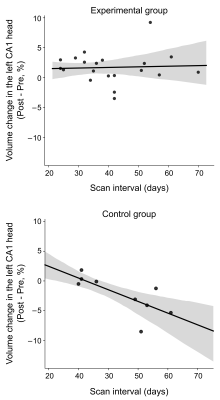 |
Positive emotional training with real-time functional MRI amygdala neurofeedback increased hippocampal volume for PTSD
Masaya Misaki1, Beni Mulyana1,2, Vadim Zotev1, Brent E Wurfel3, Frank Krueger4, Matthew Feldner5, and Jerzy Bodurka1,6
1Laureate Institute for Brain Research, Tulsa, OK, United States, 2Electrical and Computer Engineering, University of Oklahoma, Tulsa, OK, United States, 3Laureate Psychiatric Clinic and Hospital, Tulsa, OK, United States, 4Neuroscience Department, George Mason University, Fairfax, VA, United States, 5Department of Psychological Science, University of Arkansas, Fayetteville, AR, United States, 6Stephenson School of Biomedical Engineering, University of Oklahoma, Norman, OK, United States
While small hippocampal volume is a prevalent neurostructural abnormality in posttraumatic stress disorder (PTSD), whether hippocampal atrophy is a reversible alteration or a permanent trait is unclear. This study examined a volume change among hippocampal subfields due to positive emotion training with left amygdala (LA) fMRI neurofeedback (LA-NF) in PTSD participants. A significant volume increase was seen in the left CA1-head region after the training. This indicates that the small hippocampus in PTSD is a reversible alteration in a part of the subfields and that positive emotion training with LA-NF could induce a hippocampal volume recovery.
|
||
0200.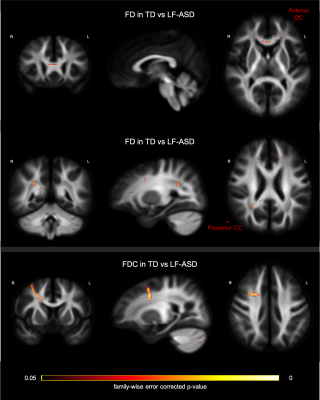 |
Reductions of fibre-specific white matter metrics in autism are determined by the level of intellectual functioning: a fixel-based analysis
Chun-Hung Yeh1,2, Rung-Yu Tseng1, Susan Shur-Fen Gau3, and Hsiang-Yuan Lin4
1Institute for Radiological Research, Chang Gung University and Chang Gung Memorial Hospital, Taoyuan, Taiwan, 2Department of Child and Adolescent Psychiatry, Chang Gung Memorial Hospital, Linkou Medical Center, Taoyuan, Taiwan, 3Department of Psychiatry, National Taiwan University Hospital and College of Medicine, Taipei, Taiwan, 4Azrieli Adult Neurodevelopmental Centre and Adult Neurodevelopmental and Geriatric Psychiatry Division, Centre for Addiction and Mental Health, Department of Psychiatry, University of Toronto, Toronto, ON, Canada
Based on the multi-band multi-shell diffusion MRI data acquisition and fixel-based analysis, the purpose of our study is to provide more insights into neurobiological accounts of autism, inclusive of understudied low functioning individuals. Preprocessed DWI data of 38 TD and 65 autistic participants were analysed. We found reduced fibre density in the splenium of the corpus callosum in autisitic individuals. This autism-associated alteration appears to be mainly driven by those autistic individuals with developmental disabilities. Our findings suggest studies inclusive of autistic people comorbid with developmental disabilities using the novel models may bridge some heterogeneity noted in the literature.
|
||
0201.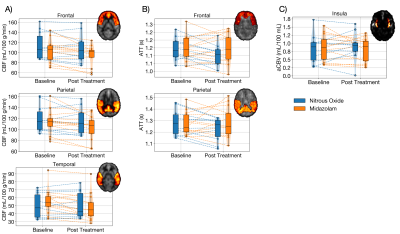 |
Cerebral hemodynamic alterations associated with an in-scanner drug trial in adults with bipolar depression
William S.H. Kim1,2, Mikaela K. Dimick3,4, Danielle Omrin4, Beverley A. Orser4,5, Benjamin I. Goldstein4,6, and Bradley J. MacIntosh1,2
1Department of Medical Biophysics, University of Toronto, Toronto, ON, Canada, 2Sunnybrook Research Institute, Toronto, ON, Canada, 3Department of Pharmacology and Toxicology, University of Toronto, Toronto, ON, Canada, 4Sunnybrook Health Sciences Centre, Toronto, ON, Canada, 5Department of Anesthesiology and Pain Medicine, University of Toronto, Toronto, ON, Canada, 6Department of Psychiatry, University of Toronto, Toronto, ON, Canada
Multiple post-label delay (multi-PLD) arterial spin labeling (ASL) magnetic resonance imaging is one approach to monitor cerebral hemodynamic drug responses. In addition to cerebral blood flow (CBF), it is possible to map arterial transit time (ATT) and arterial cerebral blood volume (aCBV). Here, we investigate multi-PLD ASL-derived CBF, ATT, and aCBV responses to a single treatment of either: 1) nitrous oxide or 2) midazolam among adults with treatment-resistant bipolar depression. Between baseline and post-treatment timepoints, we report treatment effects on CBF change in the temporal lobe and on ATT change in the frontal and parietal lobes.
|
||
0202.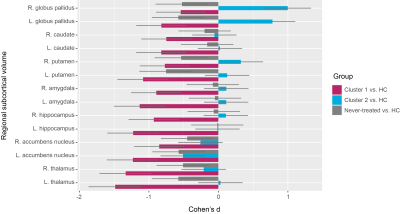 |
Disparate Cognitive Patterns Captured by Subcortical Profiles in Schizophrenia
Qiannan Zhao1, Hengyi Cao1,2,3, Yuan Xiao1, Qiyong Gong1, and Su Lui1
1Huaxi MR Research Center (HMRRC), Department of Radiology, West China Hospital, Sichuan University, Chengdu, China, 2Division of Psychiatry Research, Zucker Hillside Hospital, Glen Oaks, NY, United States, 3Center for Psychiatric Neuroscience, Feinstein Institute for Medical Research, Manhasset, NY, United States
Subcortical morphological abnormalities are associated with cognitive impairment in schizophrenia. We hypothesized that patients with different degree of cognitive impairment might be separated by subcortical morphological abnormalities. Here we identified two distinct clusters in patients with schizophrenia based on their regional subcortical volume. Different degree of regional subcortical volume, global brain volume and cognitive impairment were observed between two clusters of patients, with more severe cognitive impairment in the more severe morphological deficit cluster. These findings indicate critical relationships between subcortical structures and cognition in schizophrenia, and suggest that subcortical morphological abnormalities could help to capture cognitive profiles in schizophrenia.
|
||
0203.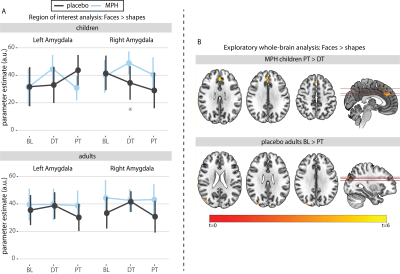 |
Age-dependent effects of methylphenidate on emotional dysregulation: an RCT in stimulant treatment-naïve male ADHD patients
Antonia Kaiser1, Marco A. Bottelier1,2, Michelle M. Solleveld1, Hyke G.H. Tamminga1,3, Cheima Bouziane1, Ramon J.L. Lindauer4,5, Paul J. Lucassen6, Michiel B. de Ruiter1,7, Anouk Schrantee1, and Liesbeth Reneman1
1Department of Radiology and Nuclear Medicine, Amsterdam UMC, University of Amsterdam, Amsterdam, Netherlands, 2Child Study Center, Accare, Groningen, Netherlands, 3Dutch Autism and ADHD research center, University of Amsterdam, Amsterdam, Netherlands, 4Department of Child and Adolescent Psychiatry, Amsterdam UMC, University of Amsterdam, Amsterdam, Netherlands, 5De Bascule, Academic Centre for Child and Adolescent Psychiatry, Amsterdam, Netherlands, 6Brain Plasticity Group, Swammerdam Institute for Life Sciences, Center for Neuroscience, University of Amsterdam, Amsterdam, Netherlands, 7Division of Psychosocial Research and Epidemiology, Netherlands Cancer Institute, Amsterdam, Netherlands
Emotional dysregulation (ED) is an important outcome moderator of Attention-Deficit/Hyperactivity Disorder (ADHD). We previously found that acute administration of methylphenidate age-dependently modulated neural mechanisms underlying ED, i.e., amygdala reactivity, but effects of chronic methylphenidate administration remain unknown. Following randomization to 16 weeks of methylphenidate or placebo treatment, we here report a lasting improvement in ED, depressive and anxiety symptoms in ADHD children, whereas a transient improvement of ED and depressive symptoms occurred in adults, independent of treatment condition. Although depressive and anxiety symptoms at baseline negatively predicted ADHD symptom change in adults, age-dependent effects on amygdala reactivity were absent.
|
||
0204.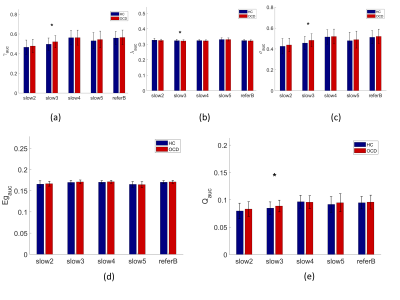 |
Application of graph theory across multiple frequency bands in obsessive-compulsive disorder
Xue Li1, Hailong Li2, Lingxiao Cao2, Jing Liu2, Haoyang Xing1, and Xiaoqi Huang2
1Department of Physics, Sichuan university, chengdu, China, 2Huaxi Magnetic Resonance Research Centre (HMRRC), West China Hospital of Sichuan University, chengdu, China
Graph theoretical approaches across multiple frequency bands were adopted to investigate whether there exist specific frequency band-related changes of brain functional connectome in OCD patients. We found significant between-group differences of global metrics only at slow-3 band (.074–0.198 Hz), On local metrics, we observed a frequency-dependent characteristic. The results suggested that multiband measurement indeed provided some new insight about the nature of brain functional connectome changes in OCD, future studies should take the different frequency bands into account when measure brain’s spontaneous activity.
|
The International Society for Magnetic Resonance in Medicine is accredited by the Accreditation Council for Continuing Medical Education to provide continuing medical education for physicians.